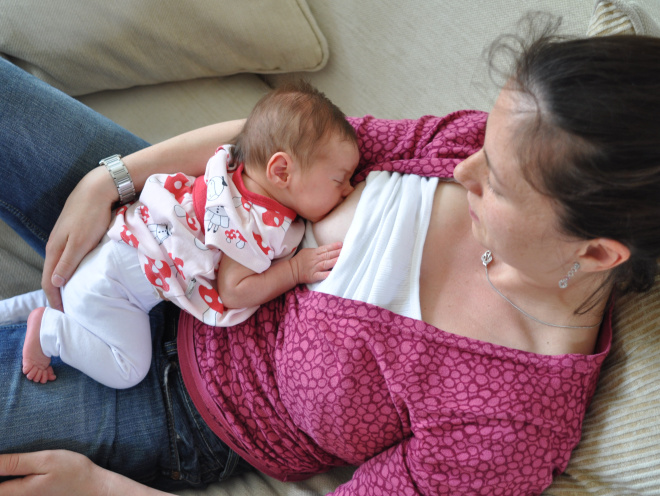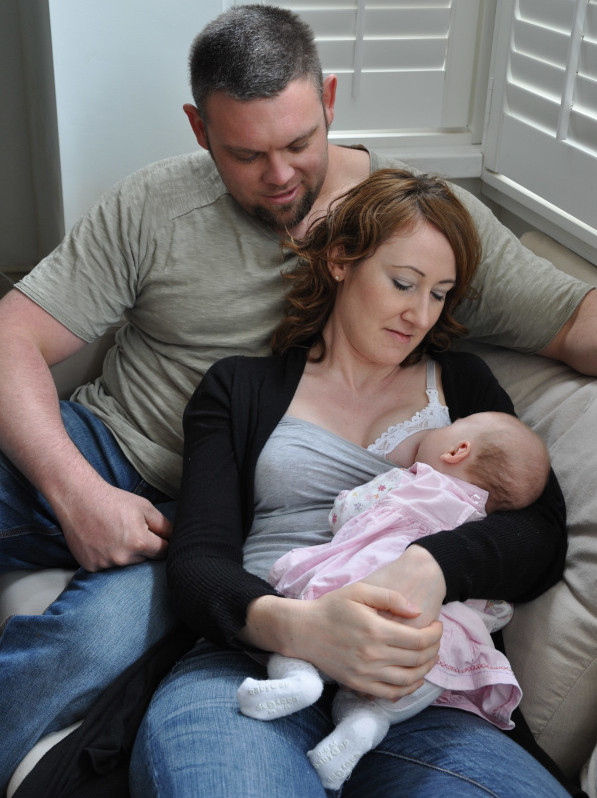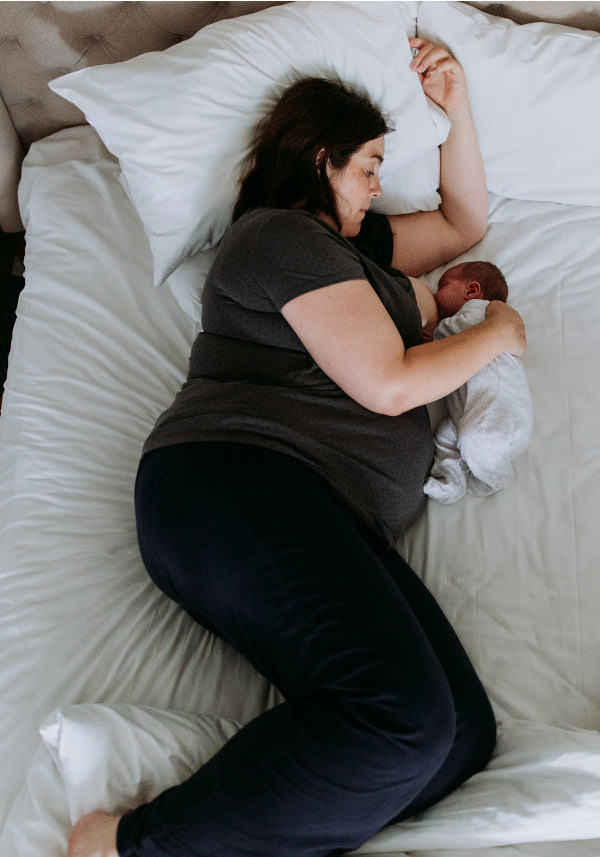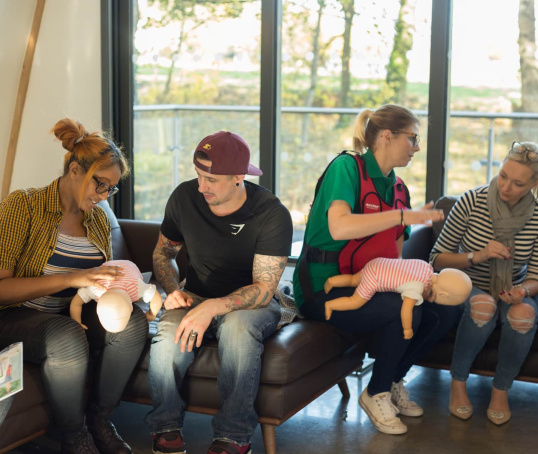Here we provide tips on breastfeeding positions, including laid-back, lying down, sitting upright and underarm positions.
The way you hold your baby or position them will affect how easy it is for them to breastfeed effectively. You can breastfeed your baby in many different positions, so it’s good to try different ones. This helps you find what’s most comfortable for you and allows your baby to get just the right mouthful of breast to feed effectively and easily.
Breastfeeding positions for newborns
When you first start breastfeeding, you and your baby may take a while to master this new skill. Patience and trying different positions will help you find a position that works for you both.
Our video has some great tips on different ways to hold your baby.
If you're having problems breastfeeding, or with latching or attachment, do call our infant feeding support line on 0300 330 0700 to talk to a breastfeeding counsellor. Your midwife or health visitor may know about local breastfeeding support groups.
Getting some support with breastfeeding can help you to get comfortable in one or more of the breastfeeding positions that we describe in this article.
Here’s how to get started…
Preparing to feed
Your baby will be happier and will latch more easily if you can identify and respond to their early feeding cues. If they are crying or upset, they need to be calmed before they are ready to feed.
Holding them against you, talking to them, walking around or gently rocking might help if they need to be calmed. Most babies like to have their hands free to touch and stroke your breast; this helps to reassure them that they are in the right place.
Read more about getting started with breastfeeding in our article here.
Laid-back position
With laid-back breastfeeding, your body completely supports your baby’s body. Your body will be reclined and may be supported with pillows or cushions. The baby is laid on your body, either skin-to-skin or lightly clothed. They are supported, but not held firmly, and allowed to move towards the breast.
Research shows that lying like this encourages your baby’s instincts, such as rooting. It is also more comfortable for you both and means gravity works in your favour, generally encouraging a deeper latch (Coulson, 2012). To read more about laid-back breastfeeding, see our article here.
Feeding in a laid-back position, using biological nurturing to latch baby onto the breast, reduces breastfeeding problems, including sore and cracked nipples (Milinco et al, 2020).
Mothers can feed their babies in this position lying back in bed, on a sofa and even reclining gently in a chair.
Sitting upright
This is a position we often see women feeding their baby in when out and about, and many find it more versatile as their baby gets bigger.
The baby lies across your body, tummy turned inwards towards you (tummy to mummy), with your arm supporting your baby’s body and holding it in place. When helping your baby latch on in this way, it’s best to position them so that their nose is level with your nipple and their chin is touching your breast. The baby’s body needs to be in a straight line, not twisted or as if baby’s head is turned towards their shoulder.
To help your baby achieve a deeper latch in this position, it is best if the hand supporting the baby is across their shoulders, and not holding their head. It can be helpful to keep the baby’s bottom tucked close with the opposite arm (NHS, 2020; NHS and UNICEF, 2022).
This position is often referred to as a 'cradle' or 'cross-cradle' hold, depending on which arm is holding the baby. In the cradle hold, the arm on the same side of the body as the breast the baby is feeding from supports the baby. In the cross-cradle hold, the opposite arm supports the baby.
Lying down
In this position, you lie on your side, with your head on a pillow and your lower arm above your baby. Your baby can then lie on their side, facing you and very close to your body, with the baby’s nose in line with your nipple. You can either guide them to your breast or allow them to take the breast into their mouth by themselves.
A pillow behind you will support your back. A thin pillow or folded towel under your rib cage will lift your body slightly and is helpful if you have large breasts. If you are feeding your baby in this position and are tired, do make sure your baby is safe from duvets or pillows.
If you’ve had a caesarean, stitches or need to stay in bed, breastfeeding lying down can be relaxing and help you get more rest (NHS, 2020; La Leche League, 2022).
Underarm or rugby ball
Holding your baby under your arm may be suggested to women who have given birth by caesarean, to avoid pressure on the wound. This position might also be suggested to mothers of twins. However, it can be difficult to maintain this position as the baby’s weight is being taken by the mother’s hand. Babies soon outgrow this position, and it doesn’t allow them to use their instincts and reflexes to attach on to the breast (NHS, 2020; La Leche League, 2022).
Breastfeeding positions for a fast milk flow
If you have a fast milk flow, this could be due to a large supply of breast milk. A fast milk flow can make your baby cough, splutter and come off the breast, which is sometimes similar to reflux symptoms. If they’re having problems, it could be that the baby needs more control when they’re feeding. If this is the case, laid-back feeding, where the baby is more in control, could be useful as it helps your baby to attach better and pull back if they need to take a break.
Breastfeeding your baby as they grow
As your baby grows, they become more active in getting themselves into position, and they're longer and heavier. So you might need to adjust you and your baby’s position to continue to feed comfortably and effectively.
A laid-back breastfeeding position could be useful with larger or older babies as you do not have to use your arms to hold their weight. You can always ask a breastfeeding counsellor for support with finding positions that suit you and your baby.
Breastfeeding position tips
Whichever breastfeeding position you choose, remember…
- Get comfortable before you start.
- Tuck your baby in closely to you.
- Bring your baby to your breast or let them attach themselves rather than leaning towards them.
- Avoid putting the breast in your baby’s mouth; let them take it in themselves.
- Check that their ear, shoulder and hip are all in a line – not twisted round.
- If you are bringing your baby to your breast, make sure they are turned towards your breast, with your nipple level with baby’s nose – they shouldn’t have to turn their head.
- Cushions, special breastfeeding pillows and other supports can prevent your baby’s body from getting close enough to your body or may raise your baby’s body too high for effective attachment. It’s best to get your baby attached to the breast, then if support is needed tuck a pillow in under your arm at the point where you are feeling strain from the weight of the baby.
(UNICEF and NHS, 2022)
Many women and babies take a while to get used to breastfeeding and it can take a while to find the position(s) that work best for you. Experimenting with different positions can help you find the ones that work best for you and your baby.
Page last reviewed December 2022.
Further information
NCT supports all parents, however they feed their baby. If you have questions, concerns or need support, you can speak to a breastfeeding counsellor by calling our helpline on 0300 330 0700, whether you are exclusively breastfeeding or using formula milk. Breastfeeding counsellors have had extensive training, will listen without judging or criticising and will offer relevant information and suggestions. You can also find more useful articles here.
National Breastfeeding Line (government funded): 0300 100 021.
For further information on how to breastfeed, including positioning and breastfeeding attachment, and a section on expressing your breastmilk by hand, visit Unicef's Baby Friendly Initiative support area for parents.
Bump to Breastfeeding DVD: available from your midwife or library – see more at www.bestbeginnings.org.uk
Coulson S. (2012) Biological nurturing: the laid-back breastfeeding revolution Midwifery today. 101. Available at: https://midwiferytoday.com/mt-articles/biological-nurturing/ [Accessed 7th November 2022]
La Leche League. (2022) Positioning. Available at: https://www.llli.org/breastfeeding-info/positioning [Accessed 7th November 2022]
Milinco M, Travan L, Cattaneo A, Knowles A, Sola MV, Causin E, et al. (2020) Effectiveness of biological nurturing on early breastfeeding problems: a randomized controlled trial. Int Breastfeed J. 15(1):21. Available at: https://doi.org/10.1186/s13006-020-00261-4
NHS. (2020) How to breastfeed. Available at: https://www.nhs.uk/start4life/baby/feeding-your-baby/breastfeeding/how-… [Accessed 7th November 2022]
UNICEF; NHS. (2022) Off to the best start. Available at: https://www.unicef.org.uk/babyfriendly/baby-friendly-resources/breastfe… [Accessed 25th November 2022]










